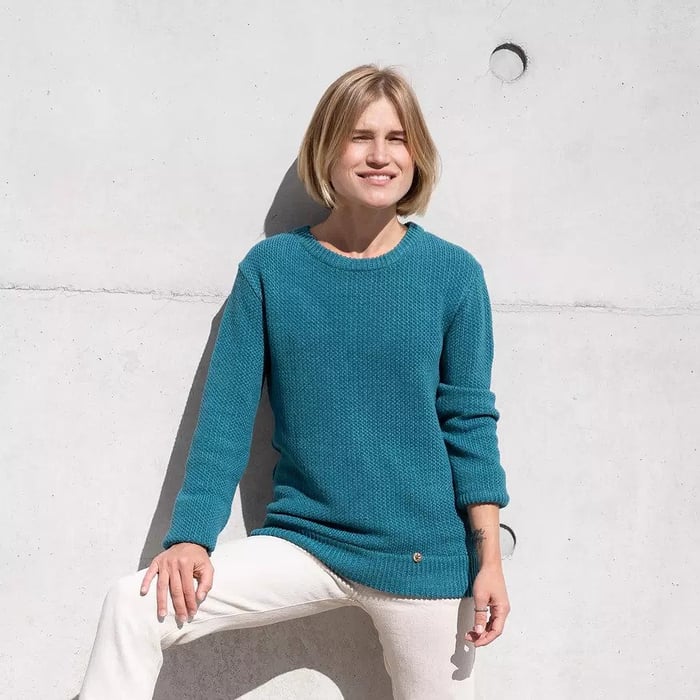
You're ready to change the world by changing your wardrobe. Embracing the world of eco-fashion is a great step to living a more sustainable life. We’re so proud of you.
As much as we all love fashion, the industry contributes to 10% of global greenhouse emissions and is the second-largest consumer of the world’s water supply. The life process of fabric goes through countless resources, from oil, land, and water, to pesticides, chemical agents, and dyes. This leads to severe pressure on the planet, contributing to the depletion of its resources.
So, now that you're ready to make more sustainable choices, one of the questions we know you might be asking is which clothes—which fabrics—are actually sustainable? Let us help you understand more about sustainable fabrics through this guide.
The sustainability of fabrics is divided into three categories:
1. Resources: What is the dependency on water, pesticides, land and energy? Also, how much carbon emissions are caused in the process of creating the fabric.
2. Treatment: Does it use harmful chemicals? How intensive is the process?
3. Disposability: How are fabrics disposed of? What is the longevity of the fabric? Is it durable? Is it recycled and biodegradable?
Several organizations have established certifications for fabrics like cotton and linen such as the National Organic Program, Fairtrade, Organic Content Standards, Global Organic Textile Standard certification, Soil Association and Oeko-Tex. Look for these certifications that guarantee you that your clothing is free from toxic chemicals and pollutants, from harvest to the factory and to you.
So which are the most sustainable fabrics out there?
Hemp
 Photo: Bewusst
Photo: Bewusst
Hemp tops the list of sustainable fabrics. Hemp is derived from the stem of the plant. It is naturally pest-resistant, antimicrobial and sun protective. It requires no pesticides, herbicides or fungicides. Hemp needs a relatively small amount of land to cultivate and less water. Hemp fabric is highly UV-resistant. It keeps you warm in the winter and cool in the summer. Hemp grows almost everywhere, cleans air and soil. Due to the high oxygen content of the hemp fibers, no anaerobic bacteria can settle, so clothes made of 100% hemp remain hygienic and smell neutral. The hemp fiber is 8x stronger and 4x more durable than the cotton fiber.
Bewusst is a 100% hemp clothing brand from Germany. This brand was launched in 2015 and since then has been selling organic hemp clothing in over 25 counties. All their dyed hemp fabrics are GOTS certified (Global Organic Textile Standard) and made from plant resources.
Organic Cotton
 Photo: People Tree
Photo: People Tree
Organic cotton minimizes environmental impact compared to conventional cotton. It takes 20,000 liters of freshwater to make a single kilogram of regular cotton. Organic cotton however uses 91% less water than regular cotton. Organic cotton fosters soil fertility and uses no pesticides.
The Higg Materials Sustainability Index shows that recycled cotton is a more sustainable alternative to both conventional and organic cotton. Recycled or upcycled cotton is made using post-industrial and post-consumer cotton waste. Recycled cotton helps reduce water and energy consumption, as well as keep cotton clothes out of landfills.
United Kingdom-based brand People Tree is a pioneer in slow fashion. It produces Fairtrade and environmentally sustainable clothing—partnering with artisans and farmers in developing countries to produce garments made with organic materials using traditional skills. People Tree launched their first fashion range to meet the Global Organic Textile Standard certified by the Soil Association and was the first fashion company to be awarded the Worl Fair Trade Organization product label.
Organic Linen
 Photo: Linenfox
Photo: Linenfox
Linen is made from the stem of the flax plant. It's naturally moth resistant and gets stronger with every wash. It is breathable and when untreated, entirely biodegradable. Linen can be grown in poor quality soil, requires minimal water and no pesticides. Ensure that you buy organic linen, with eco-friendly dyes to ensure it’s sustainable and can be easily biodegradable.
This Lithuanian fashion brand called Linenfox makes durable linen pieces that are non-toxic, follow Fair Trade principles and are OEKO-TEX certified. Linenfox reduces fabric waste by selling their fabric scraps and making garments from multiple fabric pieces.
Tencel
Tencel is a light cellulose fabric that is created by dissolving wood pulp. It is said to be 50% more absorbent than cotton and requires less energy and water to produce. Created by Austrian textile giant Lenzing, Tencel is softer and more breathable than cotton. It is produced in a closed-loop system which means 99% of the chemicals used in the process to break down the wood pulp are recycled with minimal waste and low emissions.
Econyl
 Photo: Outerknown
Photo: Outerknown
Nylon is an environmental disaster. Producing nylon creates nitrous oxide, a greenhouse gas that is 300 times more potent than carbon dioxide. However, Econyl is a great eco-alternative for nylon. Econyl is created using synthetic waste, such as industrial plastic, waste fabric, and fishing nets from the ocean, which are then recycled and regenerated into a new kind of yarn that is exactly the same quality as nylon. Econyl is embraced by brands such as Stella McCartney, Outerknown and allSisters.
Innovative Fabrics
Are you ready to wear clothes made from pineapple, apple, mango or even mushroom? Designers and inventors are innovating new kinds of sustainable fabrics, many of which have been developed from agricultural waste. Solving two problems in one, these exciting fabrics turn wastage caused by food consumption into natural fibers for the fashion industry
Pinatex
 Photo: Altiir
Photo: Altiir
An estimated 40,000 tonnes of pineapple waste is generated globally each year. Ananas Anam, makers of Piñatex which utilizes waste taken from pineapple plantations in the Philippines and turns it into a non-woven fabric that can be used for clothes, footwear or furniture. Ananas Anam supports rural farming communities in the Philippines and takes a cradle-to-cradle approach, which means that waste from one process is used in other processes so that nothing is wasted. This brand was certified as a cruelty-free label by PETA.
Pinatex is slowly gaining popularity in the mainstream fashion world. Eco-activist Livia Firth wore a dress made from Piñatex ORO, created by Italian designer Laura Strambi to the 2017 Met Gala. Hugo Boss was one of the first few brands to use Pinatex leather to make fashion accessories. Another brand called Altiir creates luxury garments for today’s conscious individual with Pinatex and other vegan materials.
Fruitleather Rotterdam
About 45% of all fruit grown globally is discarded between the field and the plate. Fruit and vegetables represent 24% of the food thrown out by households and small businesses. Fruitleather Rotterdam is tackling food waste through fashion. This brand creates fruit leather from unsold food collected from Dutch distributors. The fruits are deseeded and mashed before being boiled to eliminate bacteria and prevent rotting. The fruit soup is then spread on a surface for drying. This produces sheets of material that can be easily worked, sewn, and printed like genuine leather. Luxtra started by Jessica Kruger] is one of the first retailers in the United Kingdom to launch designs made from mango leather created by FruitLeather Rotterdam.
Pellemela
 Photo: Caval
Photo: Caval
Pellemela made from apples was invented in Italy by Frutmat. Frutmat specializes in reusing biowaste, to create a leather alternative that can be dyed without using chemically intensive techniques. Caval, a popular sneakers brand, launched unisex vegan sneakers made with Pellemela. While apple leather is mostly used in accessories, it is yet to make inroads into clothing.
Mylo
 Photo: Stella McCartney
Photo: Stella McCartney
Recently, celebrated fashion designer Stella McCartney revealed that her latest garments are made of a material called Mylo, a vegan alternative to leather derived from mushrooms. Mylo is soft, supple, and less harmful to the environment. Mylo is made from mycelium that is grown from mulch and water. Mylo is certified bio-based, which means it’s made predominantly from renewable ingredients found in nature today. Mylo products are used by brands like Adidas and lululemon.
Fabrics that are a big NO
Sadly, many of the world’s most popular fabrics are some of the most harmful to the environment. Synthetic materials like polyester, spandex, rayon, nylon and acrylic are essentially types of plastic made from petroleum and can take hundreds of years to biodegrade. These fabrics also shed microplastics every time they are washed, polluting our water systems. Terms like “easy care”, “wrinkle-resistant” or “stain-free” often mean that the fabric has been chemically treated. In addition to the fabrics, it's also important to choose naturally dyed fabrics that come from fruits, vegetables and other mineral sources like tree bark and roots. Unbleached-undyed clothes conserve resources, prevent pollution, and are environmentally safe.
We know that it isn’t always easy to figure out if a brand or a product is sustainable or not. We hope that this guide helps you ensure your purchases are ethical, sustainable and guilt-free. And, as you start building your new, and we’re sure pretty snazzy wardrobe, snap some cool pictures and post reviews of the products on abillion. Help other members of our community discover great products that you recommend and they’ll do the same for you.
Check out other companies that are revolutionizing vegan leather.





